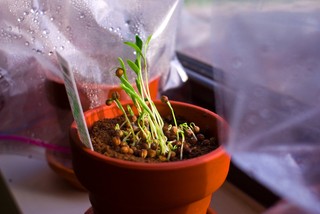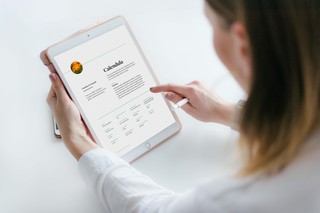How to grow the best herbs indoors

Cultivating herbs at home in containers is growing in popularity as more and more people try their hand at indoor gardening. Growing herbs indoors delivers the benefits gardening offers while providing a source of fresh herbs year round.
With some basic knowledge of what plants to grow, and how to grow them, it’s possible for anyone to have a vibrant bounty of fresh greens at their fingertips. This guide covers everything you’ll need know to start growing potted herbs inside right away.
Benefits to growing herbs indoors
Growing herbs for yourself has many benefits beyond having a constant supply of fresh foliage to use in recipes.
- After the initial investment in supplies, growing your own herbs is more affordable than constantly purchasing herbs from the market.
- Homegrown herbs are more flavorful than fresh or dried ones bought from the store.
- Herbs are accessible to harvest all year long, instead of only when conditions favor growing them outside.
- Growing your own allows you to control the fertilizers and any other chemicals applied to the plants, so you know the plant’s complete chemical history.
- Disease problems occur less often when container gardening and are easier to manage. It is also simpler to treat one container than an entire garden.
- Plants grown indoors purify the air and increase relative humidity. They also filter out environmental impurities and toxins such as formaldehyde and benzene,[1] helping clean the air.
- Indoors plants reduce stress levels,[2] lower heart rate, and bring blood pressure levels to more normal ranges. Exposure to plants is also linked to decreased anger, a fall in tension and anxiety, a drop in depression, and increased energy levels.

Two thumbs up for this inspiring windowsill grow setup. It uses a combination of natural light and grow lights on certain plants. There’s even a timer on one of the lights! Image: Missellyrh
The best herb to grow indoors
Most herbs easily make the transition to growing indoors; many actually thrive when subjected to the environmental conditions found within homes. The basic types listed below are considered some of the easiest to grow.
-
Parsley is multi-functional as both an ornamental and for its practical purposes. Curly leaf parsley is less flavorful and is primarily used as decoration. Italian, or flat-leaf, parsley is known for its robust flavor.
-
Basil plays a key role in Italian cooking. It is paired frequently with tomatoes and used in many pasta dishes. Extra leaves preserve exceptionally well in an oil or by freezing.
-
Cilantro grows best when started from seed or cuttings. Related to parsley, cilantro flavors foods in place of salt to cut down on sodium intake.
-
Thyme bears heady aromatic leaves on a low-growing evergreen plant. Its flavor depends on the variety chosen and is commonly used in meat dishes, soups, and stews.
-
Lemongrass is a tropical herb known for its citrusy flavor. It is used worldwide in various ways, most commonly for the delicate lemon flavor imparted into culinary dishes.
-
Oregano accentuates many Mediterranean and Mexican dishes. It grows well with sage, thyme, marjoram and boy as companion plants.
-
Rosemary grows as a highly aromatic evergreen shrub. Choose ordinary green rosemary over the more decorative variegated types; they are less hardy. Its strong flavoring is used sparingly in lamb, pork, and veal dishes.
-
Sage has a strong flavor, just like rosemary, and a single plant should more than meet your culinary requirements. Common, or garden, sage is the variety used in cooking.
-
Chives are a milder member of the onion family, imparting a subtle flavor in dishes.
-
Mint has the tendency to become a nuisance in the garden, taking over any free space it can. This characteristic makes it a great herb to grow indoors in a container. There are several types available; peppermint, spearmint apple mint are the most commonly grown.
-
Dill plants are popular with gardeners who pickle their own vegetables. Bouquet is the most commonly grown type and is used extensively for pickling. Fernleaf and Dukat are compact/dwarf varieties, good for container gardening.

The enthusiast's guide to herbs
We’re proud to present our new e-book, The Enthusiast’s Guide to Herbs! Learn everything you need to know about growing and caring for herbs indoors, including in-depth info cards for the 35 most commonly grown herbs.
Click the link below to find out more!
Conditions needed for indoor gardening
The environmental conditions (temperature, lighting, and humidity) found within most homes are well suited for growing houseplants and herbs alike. Most indoor plants prefer warm, sunny locations and thrive when given optimum conditions. The right ambient temperature, sunlight exposure, and relative humidity encourage vigorous plant growth and the best tasting foliage.
Ambient temperature
Bonnie Plants recommends keeping herb plants in rooms having an air temperature between 65-70℉ during the day, and dropping to no less than 50℉ at night. Many can survive nighttime temperatures below this but the drastic variation will cause plant stress and decreased growth.
Avoid putting containers in a spot where they are exposed to cold drafts from a window or door, or register vents that blow hot air in the winter and cold during the air-conditioned months of summer. If containers are close to windows, or sit in windowsills, monitor the temperature closely during the winter and the summer to avoid extremes. The extreme temperature variations cause internal stresses classified as chilling stress (occurring at temperatures below freezing), freezing stress (occurring at low temperatures above freezing), or high-temperature stress,[3] all of which hinder plant growth and yields.
Sunlight exposure
Outside, herb plants typically love full-sun locations because of their quick growth; adequate sunlight is needed to drive photosynthesis, a process within the plant that creates glucose for food.[4] Indoors they survive on a minimum of 6 hours of sunlight a day but prefer spots that receive 10-12 hours of sun.
When choosing a location for plants stick to a south or west-facing window for the best sun exposure. South facing windows provide the most sunlight, with light streaming through them all day. Windows facing westwardly are a good alternative; they receive a long period of direct sunlight but often miss the hottest, most intense part of the day.
If there isn’t enough direct sunlight for herb plants indoors, purchase a simple grow light with incandescent or fluorescent bulbs to supplement the natural light. Inadequate lighting results in tall, spindly plants that lack flavor.
Relative humidity
Indoor plants are not a fan of dry air, and herbs are no exception. To keep foliage healthy maintain a balance of between a humid environment and adequate air circulation, especially in the winter when humidity levels drop.
Group plants together to increase the relative humidity or set them in trays of pebbles that are kept moist. Be sure to allow some spacing between plants for air movement.
Different growing methods
Growing herbs indoors can be done using one of three different growing methods. The traditional way is using soil in containers, but hydroponics and aquaponics systems are gaining popularity.
Soil-based
Of the three growing methods, using soil (or coconut coir) is the most commonly used and well-known. A growing media is placed within containers, and plants are then grown in the containers.
Pros: start-up costs are low, most familiar method for growing plants.
Cons: growing media can be messy, uses more water and fertilizer than other systems.
Hydroponics
Hydroponics is a method of growing plants, without soil. In a hydroponics growing system, a nutrient-charged, aquatic solution is flushed through the root zone to provide the plants with the resources needed for optimal growth.
Pros: fewer resources are used, reduced pest problems, harvestable plants are higher quality than when grown using traditional methods.
Cons: more cost involved, more labor-intensive, takes up more space, mechanical failure is a major concern, water-based diseases spread quickly (5).
Aquaponics
Aquaponics is another innovative system for growing plants without any soil that is slightly different than hydroponics. Aquaponics is the combination of growing plants hydroponically and the practice of aquaculture (raising fish). In aquaponics fish reside in the nutrient solution, providing a natural source of organic nutrients through their waste. Microbes in the solution convert waste into forms of the nutrients plants can use; in turn, the plants filter the solution to give the fish and microbes a clean living environment.
Pros: less maintenance day to day than hydroponics systems, no need to monitor solution closely when performing at its peak, decreased pest problems.
Cons: space intensive, more startup costs involved, mechanical failure is of paramount importance, water-based diseases spread quickly,[5] pest/disease problems are harder to treat because of the fish.

Instructions for growing herbs indoors
Growing herbs indoors is similar to growing other houseplants. A basic understanding of plant care provides useful knowledge for any of the aforementioned plants. For simplicity sake, this article will only cover instructions on growing herbs in containers with soil or other growing media.
Supplies needed
There are three basic components to growing herbs in containers: the plants you want to grow, the material you want to grow them in, and the containers that will hold everything.
Containers
There are three primary aspects to take into consideration when deciding on containers for your plants: container size, the materials they are made from, and if they have drainage holes.
In terms of size, it’s critical to choose containers that are deep enough for the plant’s mature root structure and wide enough to keep from tipping over from the weight of the plant(s). Err on the side of caution and choose containers slightly larger than the plants may need.
For growing herbs indoors, opt for containers that are plastic, fiberglass, or terra cotta.
Plastic or fiberglass pots are lightweight and come in a variety of sizes, colors, and shapes. They are inexpensive, helping to keep out of pocket expenses down. Look for ones that feel sturdy yet are slightly flexible.
Terra cotta pots are breakable and heavy, but durable and long-lasting. Air movement through the pots and growing media help regulate soil moisture levels, keeping the soil from becoming waterlogged.
There is an important balance of providing plants with the right amount of moisture needed for growth while not waterlogging the root system. Look for pots with holes in the bottom to allow excess water to drain; overwatering is a critical problem as it depletes oxygen in the soil, harming the root systems.
Growing Media
Choosing a good quality growing media for containers is important: it acts as a reservoir for moisture and nutrients, it provides “empty” space for air around the roots, and it supports the plants by anchoring the roots. Coconut coir and commercial potting soils are the two most common growing substrates used in containers.
Coconut coir is composed of the brown and white fibers found between the shell and the outer coating of a coconut seed. Commercial potting soil mixes are a blend of ingredients, typically comprised of peat moss or coconut coir, pine bark, and either perlite or vermiculite. Both types of growing media are lightweight and hold moisture well, making them ideal for container plants
Plants
Plants can be started from seed, established seedlings/plants can be purchased, or new plants can be propagated from cuttings. All options have distinct advantages and drawbacks. Seeds are cheaper to buy but take more time and commitment; seedlings are more expensive but convenient; cuttings have little cost associated with them but you need access to established plants.
Instructions
Planting herbs follows the same basic indoor gardening tenants as other houseplants.
To start herbs from seeds:
- Fill the container(s) with the pre-moistened growing media of your choice.
- Sprinkle a small number of seeds across the top of the substrate. Cover them lightly with coconut coir or potting soil.
- Place container(s) in an area where the ambient temperature is at least 70℉.
- Keep the soil moist but not saturated.
- Thin plants when they reach a couple of inches tall making sure to follow recommended plant spacing for the variety being grown.
To plant seedlings and plants:
- Fill the container(s) with pre-moistened growing media of your choice.
- Create a hole in the media slightly bigger than the diameter and depth of the plant.
- Carefully plant the seedling/plant in the substrate, making sure to cover the entire root ball with growing media.
To start herbs from stem cuttings:
- Take a 4-inch stem cutting right below a node and remove all of the leaves from the bottom 2 inches of the stem.
- Place the cut end of the stem in a glass or jar of water, allowing it to grow until newly generated roots are a couple of inches long.
- Fill the container(s) with pre-moistened growing media of your choice.
- Carefully plant newly rooted cuttings in the substrate, at the recommended spacing guidelines.
Caring for plants
- Water plants only when the top 1-2 inches of the substrate is dry.
- Fertilize plants every 4 weeks using a water-soluble fertilizer at half strength.
- Harvest foliage regularly to encourage new growth.
- Monitor for pests and disease problems often, treating as soon as an infestation is observed.
Conclusion
Herbs are well suited for growing indoors in containers. When provided with the correct ambient temperature, adequate sunlight exposure, and optimum relative humidity they offer a continuous bounty of foliage for your culinary needs. They are relatively simple to care for and offer many benefits to the indoor gardener.

Join our email club—get printable info cards free!
Sign up to receive our newsletter and get access to 10 printable plant info cards from our e-book for free. Also receive:
- $4 discount code for our Guide to Herbs e-book
- Semi-weekly plant inspiration & bite-size tips and tricks
Wolverton, B. C., Douglas, W. L., & Bounds, K. (1989). A Study of Interior Landscape Plants for Indoor Air Pollution Abatement. Retrieved from https://ntrs.nasa.gov/archive/nasa/casi.ntrs.nasa.gov/19930072988.pdf ↩︎
Van Den Berg, A. E., & Custers, M. H. G. (2011). Gardening Promotes Neuroendocrine and Affective Restoration from Stress. Journal of Health Psychology, 16(1), 3–11. doi: 10.1177/1359105310365577 ↩︎
Źróbek-Sokolnik, A. (2012) Temperature Stress and Responses of Plants. In P. Ahmad & M. Prasad M. (Eds.), Environmental Adaptations and Stress Tolerance of Plants in the Era of Climate Change. New York, NY: Springer. doi: 10.1007/978-1-4614-0815-4_5 ↩︎
Smithsonian Science Education Center STEMvisions Blog. (2017, April 12). Retrieved January 7, 2019, from https://ssec.si.edu/stemvisions-blog/what-photosynthesis ↩︎
Seungjun, L., & Jiyoung, L. (2015). Beneficial bacteria and fungi in hydroponic systems: Types and characteristics of hydroponic food production methods. Scientia Horticulturae, 195, 206-215. doi: 10.1016/j.scienta.2015.09.011 ↩︎
